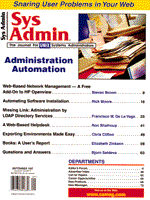
New Messages
Please send letters via email to saletter@mfi.com.
Dear Sirs,
Sincerely,
While we continuously strive to give our readers the most value for their subscription dollar, advertising falls into the same category as death and taxes - largely unavoidable even in a magazine with paid subscriptions. Ads may seem pesky, but they do serve to make our readers aware of products and services that relate to UNIX system administration, which is, after all, what we are all about. In that sense, ads are somewhat like taxes - seemingly burdensome until you need a response from the fire or police departments, or need to find a product in this case. The actual ratio of ads to editorial copy is controlled by a complex set of publishing rules, and varies little between publications of a similar type. We could, of course, do away with advertising altogether, along the lines of the $395 per year newsletters, but that might not serve our average reader well, either. Relative to content, we make a concerted effort toward tailoring the editorial content of the magazine to the needs of a majority of our readers. Our assessment of those needs is based on reader survey questionnaires that we mail to randomly selected subscribers and suggestions that we get directly from readers. Using that information, we try to keep the magazine timely and useful to as many readers as we can, evolving the content along with readers' changing interests. Thanks to all those readers who have sent in reader survey responses or emailed suggestions for article topics. -REB
Subject: Sys Admin July 97 "UNIXisms in NT" errata
Dear Ms. Myerson,
Usage: ping [-oprv] [-i address] [-t ttl] host [-n count] ping \ [-oprv] [-i address] [-t ttl] host packet-size [[-n] count] I also don't think using color for distinguishing between NT and UNIX commands a good idea. Just think of color-blind people. An alternative would be to prefix the command with the respective system prompt, like "c:>" for NT and "$" for UNIX.
Regards,
Dear Mr. Shuster: Marian Myerson
Topic: Integration Articles I was disappointed in reading your May issue on Integration reading articles about all those emulations applications out there providing Unix and NT interoperability. You need an entire IT staff to do these things and the overhead is tremendous. My disappointment came in not seeing one article about the Multi-Protocol Filer from (name of vendor deleted). If there's a reason you didn't have an article on this let me know.
Thanks,
SAMBA, the subject of two complementary articles in the May issue, has gained considerable attention within the freeware community as one piece of the integration puzzle. It was not presented as being the sole solution to the problem, however. Various commercial solutions exist, including the one purchased by Hughes, but it would be appropriate to discuss them only from within the context of a comprehensive product survey or specific product reviews. We are glad that you are satisfied with your commercial solution, however.
|